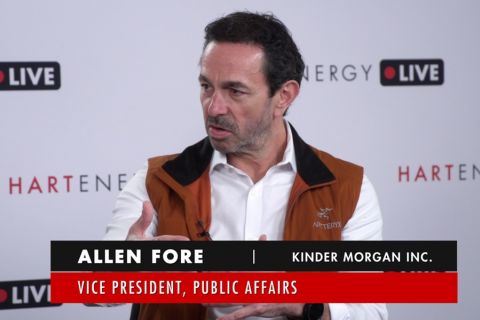
Buyers with strong balance sheets give them implied equity which enables them to increase a payout in a transactions. (Source: Shutterstock)
Small- and mid-cap E&Ps’ strong balance sheets have additional benefits to bestow as they are expected to allow for equity options that make acquisitions easier and better position the companies with credit investors.
Jay Salitza, managing director of oil and gas investment banking at KeyBanc Capital Markets, detailed these benefits of E&P balance sheet strength when he spoke at Hart Energy’s DUG Appalachia Conference in Pittsburgh on Nov. 30.
Strong balance sheets have been a priority among E&Ps in recent years as they sought to return capital to investors and reassure them that they will be better insulated in the event of another commodity bust. Those strong balance sheets will also help with consolidation driven largely by declining inventories, Salitza said.
“Companies are definitely running low on what they consider … their most valuable inventory,” Salitza said. “The world, unfortunately, is becoming much, much smaller for domestic E&Ps, especially on the private company side.”

Salitza said E&Ps are well positioned to deal with the challenge, noting that they are producing attractive dividends even after high inflation. Since 2020, the oil and gas E&P traded XOP fund has beat the S&P in returns, with the XOP returning 134% to investors compared to 25% by the S&P.
“You start to kind of understand and formulate an opinion as to why C-suite and board of directors start to think, ‘We can use equity, we can get deals done, we can grow the business,’” he said.
Equity that public companies can offer in deals also helps bridge buyer-and-seller ask spreads. Private companies, he said, have a larger cash burden for transactions.
Buyers with strong balance sheets give them implied equity which enables them to increase a payout in a transactions.
“To the extent that strategic buyers now have very healthy balance sheets, to execute a transaction they may not necessarily need to issue new primary equity. In those specific situations the strategic buyer may have the capacity within their balance sheet to execute a transaction with new debt to pay the cash component to the seller, utilizing balance sheet equity capacity as support,” Salitza said in an interview with Hart Energy following his presentation.
He said the strong balance sheets also help small and midsized E&Ps with the high yields they are facing in the credit markets.
“The credit investor looks at the cash flow yields, looks at the leverage of these companies and understands, ‘Hey, these are relatively good balance sheets now,’” Salitza said, explaining that this has the E&Ps performing at about 100 basis points better than the general high yield market.
Salitza said $3.8 billion in high-yield bond debt held by the small- and mid-cap E&Ps is set to mature in 2024. But that’s peanuts compared to the maturity walls that are coming; $7 billion of in debt is set to mature in 2025 and another $16 billion in 2026. That has many investment bankers expecting E&Ps to seek refinancing in late 2024 – and their strong balance sheets will help them do this, he said.
“I think the senior bond market is going to be very active in 2024 for E&P companies,” he said, adding that they will be further incentivized to seek refinancing if the Federal Reserve Bank cuts interest rates.
Salitza said the weighted average cost of capital, or the amount of money a company must pay to finance its operations, has become a greater factor because there are fewer banks open to the E&P space — and because bank rates are now produced with the Secured Overnight Financing Rate (SOFR) instead of the London Interbank Offered Rate (LIBOR). SOFR replaced LIBOR when bankers came to doubt LIBOR as a reliable benchmark.
He said strip pricing is another major factor in current E&P financing, and it has oil and gas in opposite places. Oil is in backwardation with near term prices more valuable than further down the futures curve, giving oil companies footing that “provides a level of finance ability to that curve where you can ultimately acquire and pay for the asset,” Salitza said.
Natural gas is in the opposite situation. It’s in contango, making financing of deals more difficult for both buyer and seller if the deals are largely debt-driven, Salitza said. He pointed out, however, that things are expected to get better for natural gas in the coming years. He pointed to data on LNG facilities, with export capabilities potentially growing from 14 Bcf/d to more than 20 Bcf/d five years from now.
“That’s significant. There are a lot of firms positioning themselves to be ready for this,” he said. “This is going to be a big driver as people start to think about M&A in the natural gas space.”
Recommended Reading
Yellen Expects Further Sanctions on Iran, Oil Exports Possible Target
2024-04-16 - U.S. Treasury Secretary Janet Yellen intends to hit Iran with new sanctions in coming days due to its unprecedented attack on Israel.
The Jones Act: An Old Law on a Voyage to Nowhere
2024-04-12 - Keeping up with the Jones Act is a burden for the energy industry, but efforts to repeal the 104-year-old law may be dead in the water.
Kinder Morgan Exec: Building Pipelines ‘Challenging, but Manageable’
2024-04-05 - Allen Fore, vice president of public affairs for Kinder Morgan, said building anything, from a new road to an ice cream shop, can be tough but dealing with stakeholders up front can move projects along.
FERC Again Approves TC Energy Pipeline Expansion in Northwest US
2024-04-19 - The Federal Energy Regulatory Commission shot down opposition by environmental groups and states to stay TC Energy’s $75 million project.
CEO: Linde Not Affected by Latest US Green Subsidies Package Updates
2024-02-07 - Linde CEO Sanjiv Lamba on Feb. 6 said recent updates to U.S. Inflation Reduction Act subsidies for clean energy projects will not affect the company's current projects in the United States.



